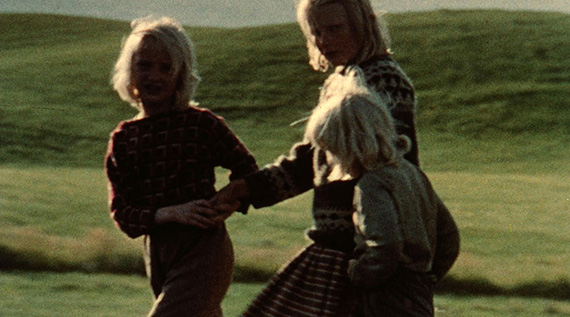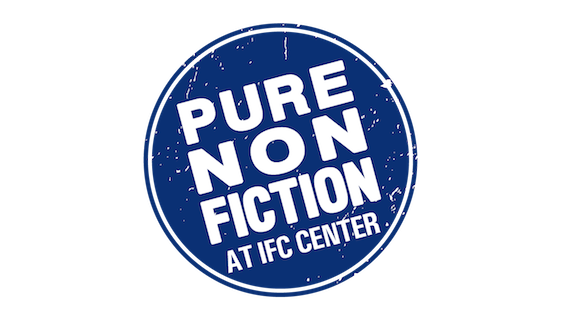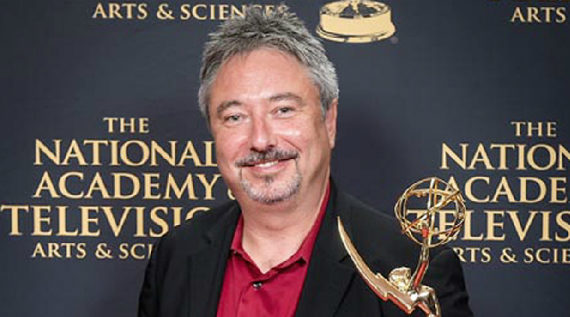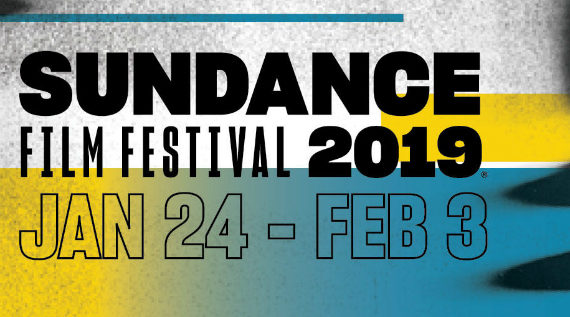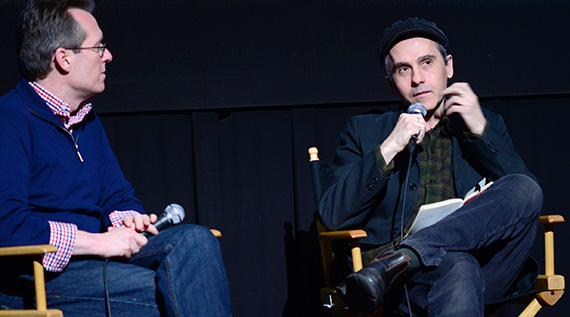
STF Artistic Director Thom Powers in conversation with filmmaker Jem Cohen (MUSEUM HOURS) following the screening of Marker's SANS SOLEIL. ©Ruth Somalo
This post was written by STF blogger Krystal Grow.
We are invited into SANS SOLEIL by the icy and congenial voice of an imaginary narrator, the only source of stability in Chris Marker‘s legendary 1983 anti-documentary which opened the 2014 Stranger Than Fiction series at the IFC Center on May 6.
An abstract travelogue punctuated by dense, poetic descriptions and lush, vibrant imagery, Marker floats through his frames with an intentional dissonance that feels both reckless and precise. Regarded as a master editor in the days before Final Cut and non-linear editing, Marker bends and twists the documentary form in a way that never claims to know the truth about anything, and questions the very nature of history, memory and reality.
The film takes massive leaps on all fronts, intellectually, technologically, aesthetically and psychologically, but at a pace that’s almost hypnotic. The female voice with the cold British accent becomes soothing to a point where Marker’s imagery starts to look like a surrealist National Geographic special, complete with viscous wildlife footage and pointed socio-cultural observations.
SANS SOLEIL is Marker’s most widely seen film, and has left an indelible impression on the cult community that’s grown around his work. Filmmaker Jem Cohen, director of MUSEUM HOURS and BENJAMIN SMOKE said he first saw the film when a group of Australian friends forced him to watch the movie soon after he arrived in the country.
“I always experience a kind of jet-lagged reverie every time I see it. ,” Cohen told STF Artistic Director Thom Powers during the Q&A session that followed the screening. “That feels appropriate,” Powers responded, as the audience slowly emerged from their Sunless-inflicted trance. “I feel like everybody needs a pause because it feels so ridiculous to do anything after seeing this film, because it’s so dense and marvelous,” Cohen said.
Even to fans like Cohen, SANS SOLEIL is essentially unknowable, a factor that Cohen said actually contributed to his love of the film. “I’m delighted to think about how utterly indescribable and unpitchable it is,” he said. “I feel like we’re in a time where documentaries are forced into situations where they have to be pitched and you’re supposed to have a one sentence line you can throw to some money person in an elevator. You cannot do that with this movie.”
Good films thrive on mystery, but Marker takes that to an almost profound level, using the conventions of documentary filmmaking to tell what could be a completely fabricated story, and by using the classic vehicle of voice-over narration to establish structure in an intentionally unstructured world. Marker takes us to places that could be familiar, but makes us question our own memories in the process of following him on his journey. We eventually come full circle, to the image that opened the film. The narrator, dictating a fictional traveler’s letters, calls it ‘the happiest image in the world.’ All the audience sees are three blonde children, staring skeptically at the camera and pondering its purpose. A fitting end to a film that defies easy answers, and demands a total dismissal of everything you thought was true about documentary filmmaking.
“It’s a film that works like memory and it works like life, so the density is to me, an appropriate function of something that is meant to feel like the way that we think, the way we remember, the way that we look and the way we experience the world,” Cohen said. “Maybe that’s dumbing down, or maybe that is just what it is.”
Full Q&A
Thom Powers: Chris Marker passed away in the late ‘90s and left behind a vast filmography that covers all kinds of topics and genres. He was also a writer that always seemed to be interested in upcoming technologies. I understand late in his life he was very interested in Second Life, the virtual reality game. Jem, Can you talk about talk about when you first encountered Marker’s work and what it meant to you?
Jem Cohen: I feel like everybody needs a pause because it feels so ridiculous to do anything after seeing this film, because it’s so dense and marvelous. I think the first thing I saw was a very early documentary of his on Siberia, which I don’t know how I would have had access to it, but there was an amazing mirage of time when things like that would end up on PBS late at night, a lot of things that would be unimaginable to broadcast today. But somehow I saw that, and then I saw LA JETEE. It was very hard to see his work, and I saw some pieces of LE JOLI MAI. In the year 2000, I visited Australia for the first time and got off the plane and confessed to my hosts that I had never seen SANS SOLEIL and they were so shocked they sat me down and made me watch it, so I always experience a kind of jet-lagged reverie everytime I see it.
Powers: That feels appropriate.
Cohen: There were bits and pieces that seemed to add up to something fascinating but it is true that you had to really seek it out.
Powers: In your own filmmaking you’ve spend a lot of time observing and taking street photography, was that coincidental to your interest in Marker? Was any of it fed or influenced by Marker?
Cohen: Influence is a mysterious, a hard to parse thing, in a way. I think one of the things about Marker that I find so wonderful is that to me he is quintessentially DIY. He cobbled things together, and an astonishing array of them, from his writing to his films to installation work and much of that was done as a one man band, and to me that’s always been fascinating, because there’s so much emphasis, when people talk about cinema, on movies that are done by massive teams of people, and an apparatus of cinema that has become synonymous with the way that most people think of the movies.
In the case of SANS SOLEIL, it’s intentionally deceptive, because some of the names you read in the credits are actually Marker, which, it was kind of a game to him, but he thought it was inelegant to put your own name a dozen times in the credits, so he devised this elaborate ruse and it amused him greatly when people would say ‘It’s so interesting that you used the music of Michel Krasna,’ when it was actually just him on the synthesizer.
I found that I came to filmmaking partly through street photography traditions which were largely about people wandering on their own with cameras, and I also had a lot of interest in certain experimental and documentary traditions where people did things in very small teams, not necessarily, entirely on their own, but compared to the way Hollywood films are made it’s very pared down. And it’s not that Marker fetishized that, he was very interested in Tarkovsky and he made a portrait of Tarkovsky and a portrait of Kurosawa while they were on set doing their work, so he wasn’t someone that would suggest that small was the only way to go, but he was often forced into that position because he didn’t have a lot of money to work with and found that frustrating like most filmmakers do, so maybe even when he wished he could do things on a bigger scale, he did it anyway.
Powers: Perhaps its helpful to get some historical perspective here. When he’s making this, it’s the 1980s. It’s a different time of technology than today. Today, it’s much more common for people to take a one man band approach because the technology is a lot simpler and more accessible.
Cohen: It’s also interesting to remember that this is pre-non-linear editing, so in that time, its all the more astonishing to think of putting something like this together without Final Cut or Avid or that kind of organizational tool that allows you to make changes so infinitely. This almost seems like a non-linear film before it’s time, but it is true that so much of what Marker does seems so ahead of its time.
Powers: Tell me about your personal interactions with him.
Cohen: They were few and I don’t want to in any way suggest that I knew him well. The thing about Marker is that there’s a lot of mystification. One of the great mystifications is that he was this great reclusive man who never allowed his picture to be taken and never did interviews and never went to film festivals. Another part of the myth is that he would sit in his loft studio and watch three or four televisions at the same time and one might be a Russian satellite feed and the other would be CNN and another one playing old movies from a VCR. He happened to be watching French television at 1 or 2 in the morning and one of my films was shown on a cable station. It was a short film that oddly ended up at that hour on French television translated. He carefully read the credits, and recognized a name of someone who did some sound work on my film, who happened to have a day job here in New York at Electronic Arts Intermix, a mostly experimental film and video art distributor, who distributed some of Marker’s works. He contacted that fellow, and left him a message that he had enjoyed my film, which of course, completely blew my mind.
I thought to myself, ‘that is not the activity of this reclusive mystery man that he had been made out to be.’ So I got in touch with him and learned over the years that he was very generous to many young filmmakers and obscure filmmakers in many countries and here in the US, he championed the work of Lynne Sachs and Travis Wilkerson and Garrett Scott. It taught me that he wasn’t really so unapproachable and I had the good fortune to meet him a few times and we would email over the years as he did with many people.
Powers: Chris Marker’s loft studio is kind of a legendary space. Can you describe what it was like?
Cohen: I think there were a few of them. The one I visited was extraordinary. It was a kind of ramshackle sort of loft area with a great many books and machines and souvenirs and a wall of vast titles that ran from one end to the other. You couldn’t help but peer over and try to see what the titles were. It was this incredible mix of the entire world of cinema. He was very familiar with Russian cinema and considered himself Russian, which some people would maybe argue with, but I saw no reason to. He also knew about very current works. When I was there, he told me to see a film called DEMI TARIF and it was quite a wonderful piece. It was an amazing place. We’re lucky that Agnes Varda did a little portrait of him in which she documents that space.
Powers: SANS SOLEIL is a work of dense poetry. I think everyone can take away their own ideas and thoughts about what it is. I wonder what are the ideas you take away from it?
Cohen: I guess there is a degree to which I feel guilty [speaking about the film]. He said he didn’t talk about the film for awhile, that he liked for there to be this sort of mist to the film, for people to walk out with and make of it what they would.
But also at some point, he responded to a fax from some young women, students maybe, who sent him questions about the film. He kindly answered [each question], and even asked them, ‘Why does everyone always refer to it as SANS SOLEIL when they could just call it SUNLESS?’ So he’s fine with that title if anyone wants to use it.
It’s very many things, it’s hard to pin it down. I’m delighted to think about how utterly indescribable and unpitchable it is. I feel like we’re in a time where documentaries are forced into situations where they have to be pitched and you’re supposed to have a one sentence line you can throw to some money person in an elevator and you have to be able to deliver a TED talk about anything that you do. You cannot do that with this film. It’s not pitchable. It’s not sellable. It doesn’t fit into any particular genre.
Marker is often said to be the inventor of the essay film. I don’t think he would agree to that. He came from a tradition in which this idea of the essay was something that he loved. He had a friend who talked about film as the “cine-pin” the idea that the filmmaker could make something that had it’s own voice and was a sort of essayistic exploration. The more that I see [the film], the simple thing I see is that it’s a film that works like memory and it works like life, so the density is to me, an appropriate function of something that is meant to feel like the way that we think, the way we remember, the way that we look and the way we experience the world. Maybe that’s dumbing down, or maybe that is just what it is.
Krystal Grow is an arts writer and photo editor based in New York. She has written for TIME LightBox, the New York Times Lens Blog and the DOC NYC blog. Follow her on Twitter and Instagram @kgreyscale.
Related Film
